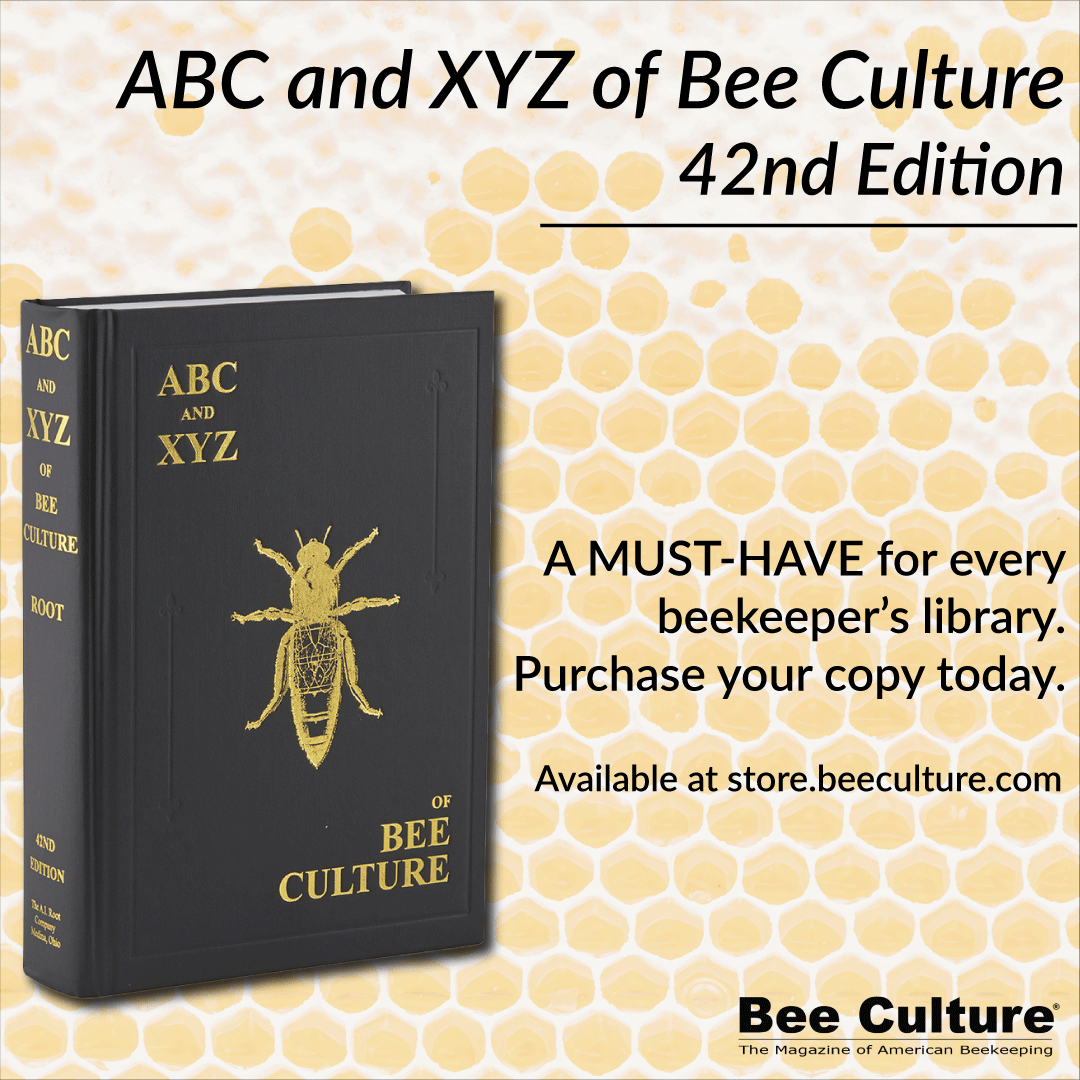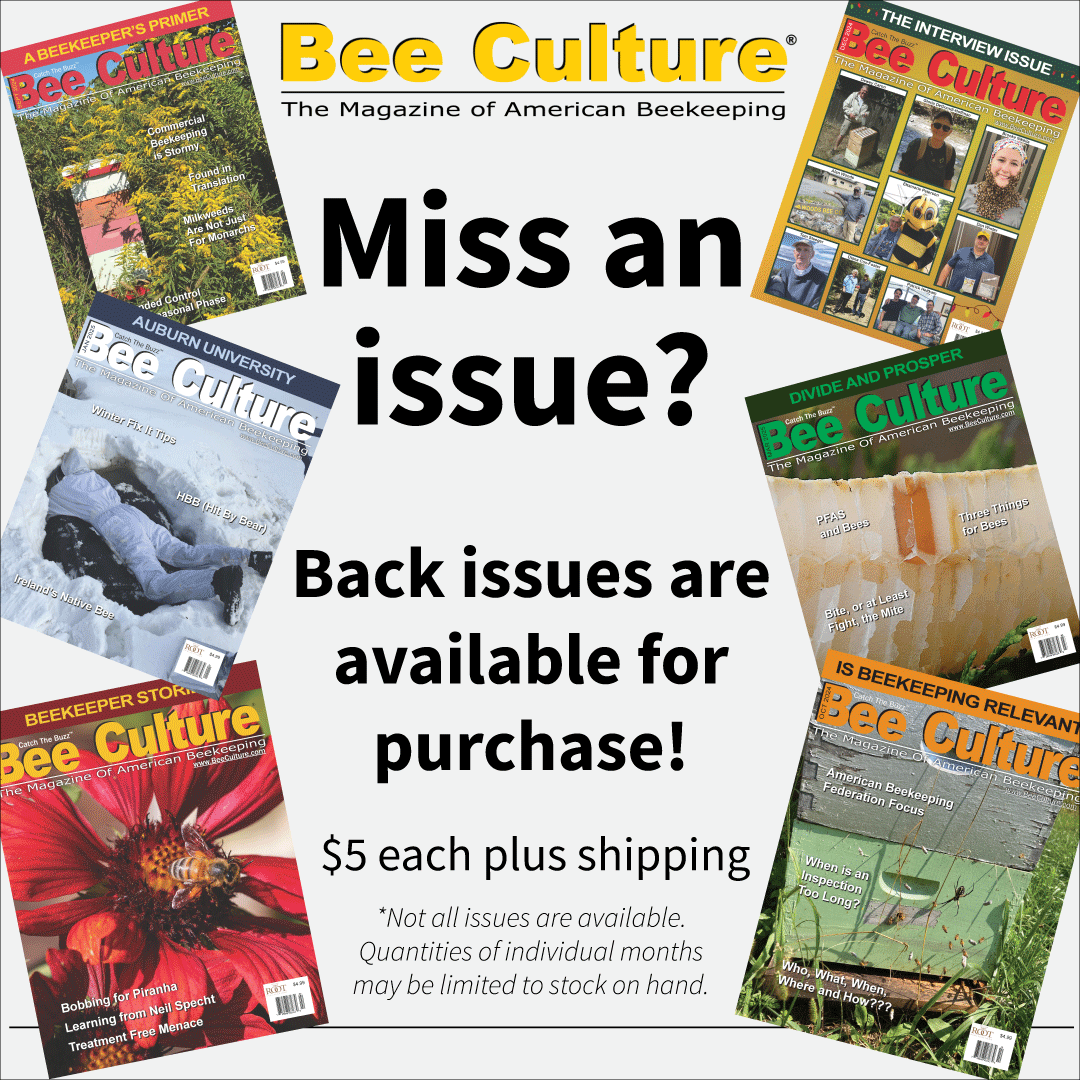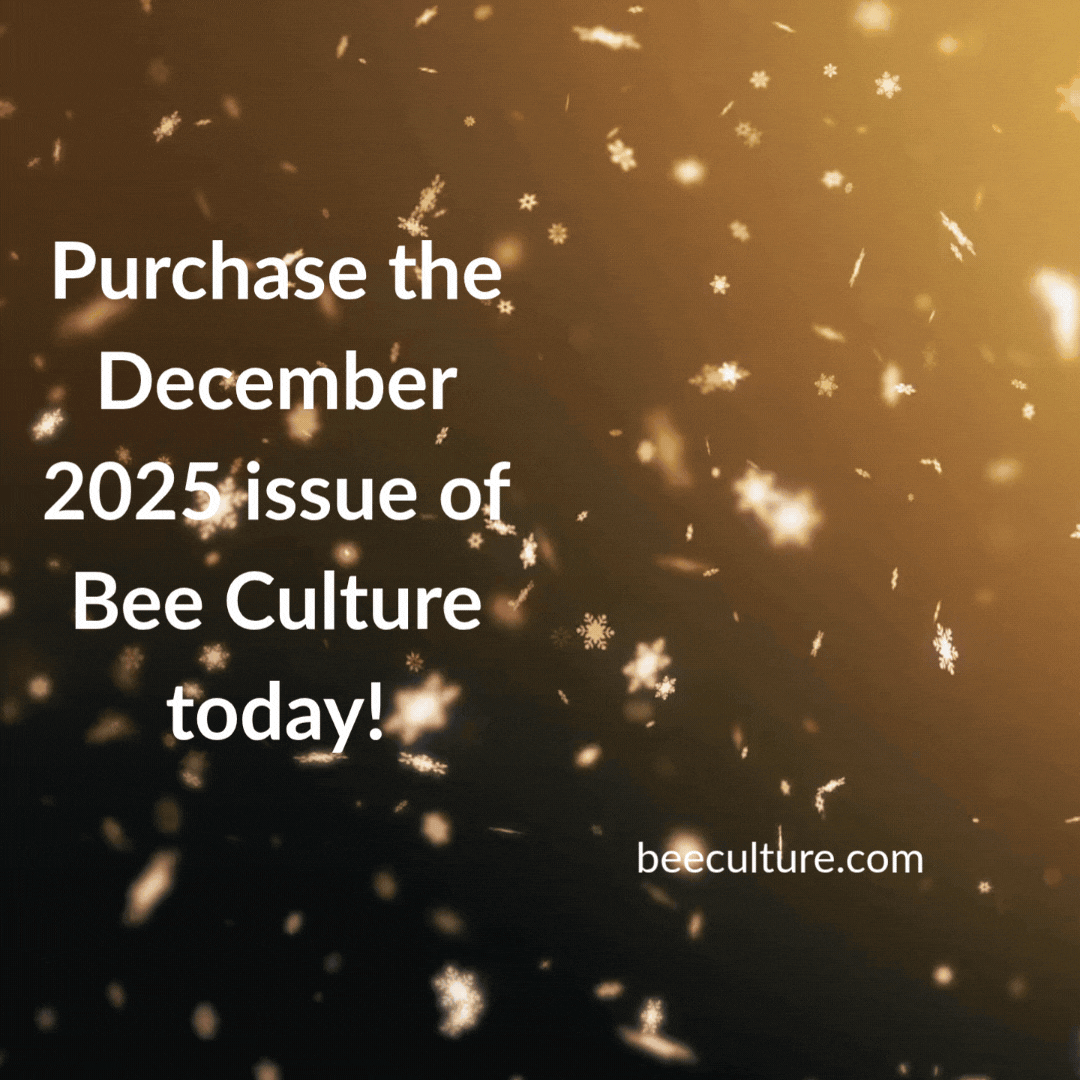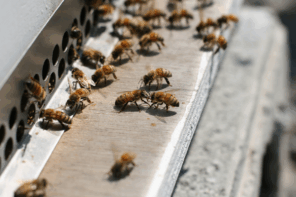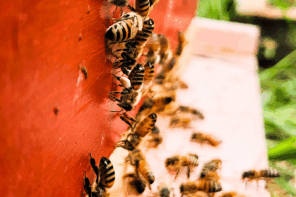Reader Survey. Meeting Messages.
By: Kim Flottum

A tip of the hat to the Ohio State Beekeepers Association
We recently conducted a reader survey. You may have been one of those contacted by the people we asked to take the survey. If you subscribe to our CATCH THE BUZZ you were on the list of folks to talk to. All told, we reached out to just over 3% of our readers for your thoughts on a variety of issues and topics relative to the magazine you receive each month.
Things have changed since our first major survey years ago, and even since the several we have conducted since then. We have far more women reading the magazine now than even a few years ago – 30 years ago it was only 5% female, but now it’s grown to 24%. That’s quite a leap, but reflects what we’ve been seeing in new beekeepers lately. That’s a good thing, and it shows we’re reaching this group.
40% of you have four or fewer hives which is fewer that the last time we counted, while 45% have between five and 25, the rest having more than 25, and of those, 2% have over 500 colonies. That five – 25 group has grown by about half actually, which is encouraging. All these numbers reflect almost exactly what our other surveys recently have shown in the numbers of colonies kept by beekeepers generally, and our readers specifically.
Interestingly, we recently had the chance to talk to the NASS folks who conduct that annual survey we use each Spring on number of colonies, amount of honey and the like (see last year’s here http://usda.mannlib.cornell.edu/usda/current/Hone/Hone-03-21-2014.pdf). They are ramping up the number of questions, the number of times they send out their survey(s), and the kinds of information they are looking for going forward. They were clever enough to ask us for some ideas, and they bounced off some of their new thoughts on this. This next year is going to be good for gathering data, and I think the picture we have of this industry will improve immensely. This is in part because of the increased funding they got, and the folks who do that are really dedicated to getting the best information they can and sharing it with the people who can use it. One thing I did find out was that the survey is sent to only about 11,000 beekeepers, about 10% or so of all the beekeepers in the US. (that number is a debate all its own though – how many people are keeping bees, today, in the US, really?). Nevertheless, they get back about 80+% of what they send out – an incredible return if you are in the survey business – and they base their data on that. Of course they don’t send to those beekeepers who have five or fewer colonies, which, it would seem is a fairly large number – 90% by my guesstimate, maybe more by others. That is one of the things they want to change however, so the picture may be a bit clearer in the future.
Meanwhile, back to our little survey. 54% of you live in what you describe as a rural environment, which is down a lot from our past surveys, and that’s because 30% now live in a major city, or the suburb of a major city – and that’s way, way up from where we were a few years back (20 years ago it was less than 10%). Of course just under 20% live in a smallish town, which has been about the same for quite a while.
And you’re getting younger. Really. Fully a third of you are under the age of 45, which is a major change because it used to be only about 20% were under that age. Still, that means more than half are older than that, but it’s definitely a move toward younger readers, and the beekeeper population in general.
Almost exactly half of the homes we send our magazine to have more than one person reading the issue each month, which tells us that beekeeping is really a family affair. That figure, 10 years ago, was less than 25%, so that’s good for us, and for those who write for us because they are reaching twice as many folks as they thought they were. That should also be a good word to those who are selling products to our readers too. (hint, hint).
Technology has caught up with you, and that’s no surprise. 95% of you have a desktop or laptop computer, 37% have an IPad or other tablet, and 51% have a smartphone (me included). By comparison, Pew Research shows that for the overall population of the U.S., 58% of American adults have a smartphone, and 42% of American adults own a tablet computer. So for those who are doing some kind of remote note taking or data collection, beekeepers, or at least our readers, are right about average.
What gets read each month? That’s the question everybody that works here wants answered, so we asked. Without too much detail the two most popular sections of the magazine each month are still the two most popular sections and have been for the 29 years I’ve been here… The Mailbox, and New Products. If there’s something you want to get read, write us a letter or send us information on your new product because every month, more than 96% or our readers regularly tune into those pages.
We asked some open ended questions too, to give folks a chance to sound off or to express an opinion that wasn’t covered elsewhere. One of these was what one thing would you add to the magazine each month? Pleasantly, for us anyway, nearly 20% wouldn’t change a thing. After that, there were not many things folks would change. Seasonal and regional information are always being looked for, and we shoot for that kind of information with some of our writers. But it’s a difficult task when you cover all of North America, Europe and parts of South America and Asia. And of course, how-to articles are always popular, and folks always want more of those. So do we, actually.
Those how-to’s you want cover disease ID and treatment, both more and less technical information (not sure how to address that) and of course more advanced and more beginner articles (not sure how to do that, either, but we’re looking into it). When asked about what you would remove, almost 60% said nothing. That’s encouraging. But, certainly we do reach out to a lot of our readers (more than 80%) who want information on topics not directly related to bees – like gardens, urban situations, bee club information, and yes, chickens, that they are also interested in. So we’ll keep covering some of those topics for the vast majority who want them.
And finally, one of the most interesting questions was the Universal Satisfaction Score. Our survey people asked, on a scale of 1 – 6, overall, how satisfied you were with the magazine – 1 being not at all, 6 being as good as it gets. When the numbers were in you gave us a 5.1 overall satisfaction score. Now, the folks who did this survey do this for a living. That’s all they do and they have hundreds and hundreds of clients so they know what they are doing, and they are good at it. This is what they told me about this Satisfaction Score – it was the highest they have ever gotten on any magazine reader survey. EVER!
So, there you are. That’s who you are and that’s what you think. We’re not perfect but we’re still trying and we thank you very, very much for your vote of approval of what we do here.
•
November and January were mostly on the Road. Trips to the Oregon Beekeepers and California Beekeepers in November, home for the Holidays in December but then the two National meetings in the Los Angeles area in January have kept me backed up a lot, but listening to a whole world of new stuff I’ll try and share. Sometimes I write so fast I can’t read it later, so please excuse any shortness of detail.
After many years, Bruce Boynton has stepped down as the CEO of the National Honey Board. Bruce served during some of the rocky periods of this commodity board and oversaw the change from a producer sponsored board to a packer sponsored board, plus a hefty increase in assessments that will enable the board to do even more in terms of both promotion, market and industry research. I imagine their contribution to honey bee health research will surpass the over $200,000 donated last year, plus all the promotional material they have and the honey locater web page they sponsor. The resources offered to beekeepers from the National Honey Board are impressive, and if you haven’t explored their offerings on their numerous web pages start at www.honey.org and see for yourself. Meanwhile, the Honey Board of Directors searched and found a new CEO, Margaret Lombard, whom we hope to talk to soon about her plans for the future. Bruce, you did a bang up job and your even handedness and easy manner will be missed. Enjoy the slopes.
I got to listen to Dennis van Engelsdorp at all of these meetings which was good because he has so much information from his BIP program to offer it’s tough to get it all in one sitting. He starts off with Winter losses, but quickly adds in Summer losses, something they just started measuring. On average, beekeepers – commercial and small lose about 20% of their hives over Summer. Commercial lose about 20% over Winter, while hobby folks lose around 40%. And it makes a difference where you live – all beekeeping is local you know – where those in the north drop more than those is the south, and commercial overall drop the least per cent.
Why? Well, among other reasons, Varroa. No surprise there, right? When asked about Varroa losses and number of treatments, interestingly, those beekeepers that treated four times/year did the best – better than less, and better than more. And the number of different products used makes a difference. 0 products used generally had about a 38% loss, two to five products used had about a 30% loss, and six products had even less. I know, the numbers don’t quite add up, but this is survey data, not research data and sometimes that’s what you get.
Speaking of Varroa – three mites/100 bees in an alcohol wash is the new reality. When you hit that mark it’s decision time. If you hit six or more your colony is already dead but hasn’t told you yet. The lesson is, test, and do something before it gets to 3/100.
BIP was looking for a similar situation when it comes to treating diseased livestock and what they found was treating mange in cattle. The practice there is to get as many animals in a herd together as possible and treat them all at the same time. That way everybody was cured, and everybody was protected. Comparing that to all the bees that are in California right about now seems almost too easy, doesn’t it?
If you’re in the market for using BIP’s tech transfer team you’ll find that if you use their information carefully you’ll have about a 20% decrease in colony losses. That’s significant, but it still isn’t sustainable. Still, for that $80 you’ll spend if you run 2500 colonies, you’ll lose 150 fewer next Winter.
Here’s an interesting, and new observation regarding Nosema cerena. Spore numbers spike in May, June and July, unlike the apis variety which shows up in Winter, BUT, they are finding that it’s NOT the number of spores they find/bee, but rather, how many bees have spores that is determining how well the colony is dealing with the disease. So, when taking samples to examine yourself keep that in mind. I think Beltsville grinds them all up together so individual counts might not work there. Can’t hurt to ask though.
Speaking of Beltsville, Jeff Pettis (the AHPAs Friend of Beekeeping award winner this year – a very good choice I might add) has some interesting information on current issues with queens and colony losses. By his reckoning beekeepers are losing about 50% of their colonies every year, a bit higher than the BIP numbers, but maybe a bit closer to what’s happening I think. Jeff isn’t surveying, he’s counting and there in lies the difference I think.
He’s looking at queen issues, specifically are pesticides in colonies, and/or in colony wax causing problems, are low sperm levels leading to early queen replacement (and what’s leading to low sperm levels?), and are post office or UPS shipping problems (specifically temperature spikes and valleys) leading to some of these issues?
One thing he’s found is that in colonies you would consider unhealthy, the queen’s sperm counts are low, and just the opposite…healthy colonies have queens with high sperm counts. Why…well, when looking at what these queens are exposed to, he found that colonies exposed to Amitraz, or imidicloprid residues led to failing colonies. Yet, sperm counts were unaffected.
But, when sorting out the issues, not a lot has changed – poor weather during mating, unhealthy or stressed drones, poor nutrition during queen cell time, simply bad stock, diseases, pesticide levels in hives – it all comes down to sperm viability. It’s the major factor in colony and queen losses he believes, with lots of causes leading there…
One of the most interesting speakers was someone new to the beekeeping crowd was Dr. Johathan Lundgren, a USDA Research Entomologist from Brookings, SD. He is a dynamic speaker who’s been off our radar because he isn’t just a bee guy, but a pollinator and cover crop guy, among other skills. But he is a biodiversity guy first and foremost. His message was very similar to that of Dr. Doug Tallamy, Univ. DE that I heard a couple of years ago at an EAS meeting. Tallamy’s message was that a lack of diversity in the urban landscape was leading to a crisis in insect populations. That the invasive ornamental trees and shrubs being used didn’t feed native insects, and their populations were rapidly declining. It’s been his influence that has led me to work with Soil and Water Conservation offices to look carefully at what plants they are offering. With a bit of study, they are now offering plants that are a benefit to pollinators and native instects, and what is it that the local bird population eats…native insects. So with care…you can feed the birds, the bees, and the butterflies with the same assortment of plants.
Well, Dr. Lundgren has the same outlook, but he’s not urban, but agricultural. His gig is that farmers should be providing pollinator strips alongside their fields using the right seed mix of course. And flowering cover crops should be part of the picture, which could be flowering biofuels certainly, so the farmer gets double duty out of them. Crops like flax, phacelia, canola, borage, calendula. Good advice…and his question is…what happens if we don’t?
When looking, what he found was that between 25 and 40% or our land is devoted to crops. Moreover, the more crop land there was, the less healthy bees in the area were. How? He captured honey bees and measured life components. Lipids, glycogen, proteins and the like. Not surprisingly, the more perennial components in the landscape, the healthier the bees, the more crop –yup, you guessed, the less healthier the bees were. Biodiversity is the key. We can, he insists, conserve species and produce crops on the same land. But we can’t do it the way we are doing it now.
Next, he dives into neonicotinoids, definitely an agricultural mine field. He quickly undresses the topic though – are they as bad as they say? And what’s the exposure opportunity for bees with these chemicals. For starters, he looked at guttation in a corn field with plants that had been seed treated – that’s water that comes from the roots and is expelled from the tips of leaves on a corn plant. He found about 2000 drinking events/ac/hour and the drinking went on for about eight hours. What he didn’t find out was how much chemical was present in that water, if any, and/or for how long if it was. That’s next. He also found that at least some of this stuff was moving off site and contaminating milkweeds on the field edges. At least 51% of the plants had the chemical in the flower’s nectar with an average concentration of .58 pbb/plant. Now six ppb apparently is toxic to a monarch butterfly – the main partaker of milkweed nectar, and even one ppb causes a sublethal reduction in adult size.
Other notes randomly taken as speakers came and went . . .
One researcher found that Amitraz was one of the problems with both worker and queen longevity issues. Another found that high Nosema spore counts correlated with low Varroa populations, and, not surprisingly, low deformed wing virus counts correlated with high Nosema spore counts. Something to keep in mind when examining your colonies this spring. And, in support of other speakers on the topic, lots and lots of pesticides in beeswax in a colony correlate with high, and rapid queen losses when new queens are put in that colony. That should tell you something, and that something is get rid of that old wax. And that is the $64 question – where do you get rid of it? Candles and ornaments and soap, oh my? Or melt it down and trade it in – so when you get more foundation you get that same pesticide load right back home? I think fire starters are good, and I think candles are good, but I don’t have a clue what to do with 1000 pounds of the stuff.
Progress from the Keystone Honey Bee Health Coalition is promising. This very diverse group is looking at hive management, forage and nutrition and cross industry collaboration in a variety of areas, including: Tech transfer investment, Varroa control tools summary, new Varroa control products, promoting bee forage on agricultural lands, and promoting enhancements for nutritional supplements. Their goal is to control crop pests and safeguard honey bees, promote best management practices to safeguard honey bees, to promote reporting honey bee health incidents related to crop pest control, to improve by working together honey bee health with public/private education, and basically to improve communication. Lofty goals, but it’s a pretty intense group, including, among others the CA Almond Board, ABF and AHPA, American Seed Trade Ass’n, Bayer Crop Science, Brown Honey, Canadian Honey council, Canola Council, CropLife America and Canada, Ducks Unlimited, DuPont, Land O’ Lakes, FL Fruit & Vegetable Ass’n, National Corn Growers, Pheasants Forever, Monsanto, National State Departments of AG, Pollinator Stewardship (the folks who write for us each month), Project Apis m, Syngenta, Unilever, United Soybean Board, MD Dept of Entomology, US Canola, plus a boatload of beekeeping and other conservation groups, and don’t forget USDA and EPA. Basically what these folks are trying to do, as I understand it, is to take all the research that has been done finding out what’s wrong, and doing something about what’s wrong so it’s not wrong any more. Fundamental research has found out, as I’ve said before, more and more about less and less, and the more we look the less we find. Well, this group is doing something about that, and it’s about time someone did.
The Coalition will have their spring meeting here in Medina hosted by Bee Culture in May, so we’ll keep you posted on progress in all these areas.
So, that’s about half of what went on. But it’s the half that did me the most good. I hope you have some insight to what’s happening. Colony and queen losses – Varroa and pesticides in the wax and shipping temperatures, poor nutrition, low sperm counts, lack of biodiversity and a host of other issues. All fixable, but all still out there to fix.
It’s February. Bees are in the Almonds. Florida’s maples are about done blooming, and in Ohio we’re still making snowmen. Get ready though, it’s coming, so keep your hive tool sharp, your smoker lit, and your veil tight. As Mark Winston says, it’s Bee Time.




